Ceratomia undulosa
Ceratomia undulosa
seer-a-TOHM-ee-uhm un-dyou-LOH-suh
The Waved Sphinx
(Walker, 1856)
Daremma undulosa
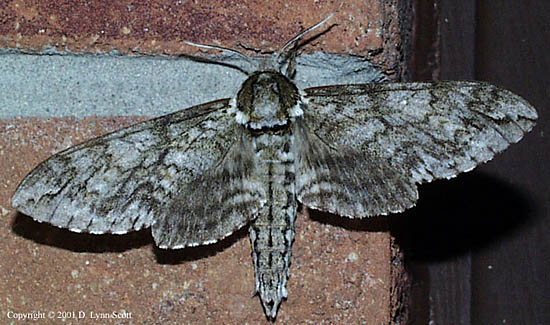
Photo courtesy of Lynn Scott.
This site has been created by
Bill Oehlke.
Comments, suggestions and/or additional information are welcomed by Bill.
TAXONOMY:
Family: Sphingidae, Latreille, 1802
Subfamily: Sphinginae, Latreille, [1802]
Tribe: Sphingini, Latreille, 1802
Genus: Ceratomia Harris, 1839 ...........
Species: undulosa (Walker, 1856)
|
DISTRIBUTION:The Waved Sphinx,
Ceratomia undulosa
[Wing span: 3 - 4 5/16 inches (7.6 - 11 cm)], is found
in Canada from Prince Edward Island and Nova Scotia westward to eastern Alberta.
In the U.S. it ranges from Maine to Florida westward
to the eastern Great Plains and south to Florida, the Gulf Coast, and Texas.The upperside of the forewing is pale
brownish gray with wavy black and white lines and a black-outlined white cell
spot. The upperside of the hindwing is gray with diffuse darker bands. Some individuals are very dark, almost black,
and others are light yellowish brown.
Image of Ceratomia undulosa in typical resting pose
courtesy of Terry Thormin. |
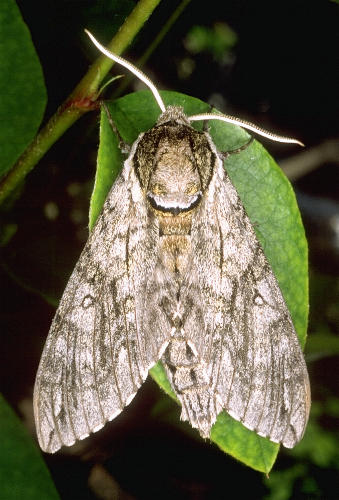 |
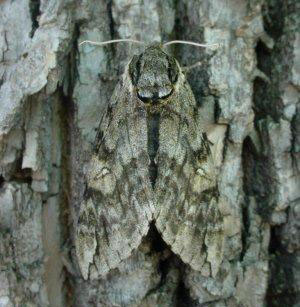 |
FLIGHT TIMES:Here on P.E.I. and in the northern portions
of its range the single brooded adults generally fly late June to early
July. From New Jersey southward and westward there are often two or more
broods with as many as six peak flight times in Louisiana beginning
in early April, repeating at roughly 30 day intervals.
Both sexes come in
to lights and females readily oviposit in paper grocery bags.
Ceratomia undulosa Edmonton, Alberta, summer 2004, courtesy of
Evie Uretsky. |
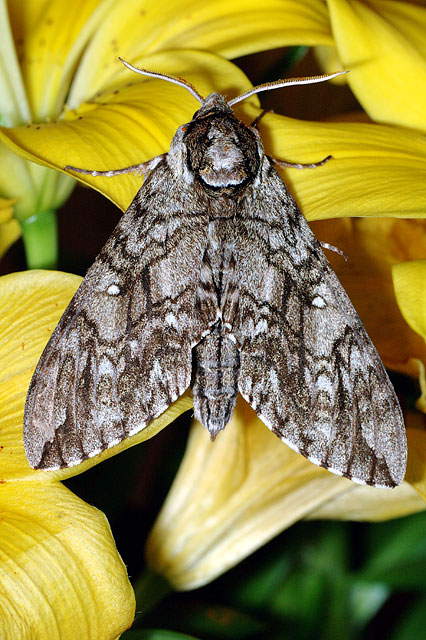
Ceratomia undulosa, Jasper County, South Carolina,
March 25, 2006, courtesy
of Dr. Wasil Khan.
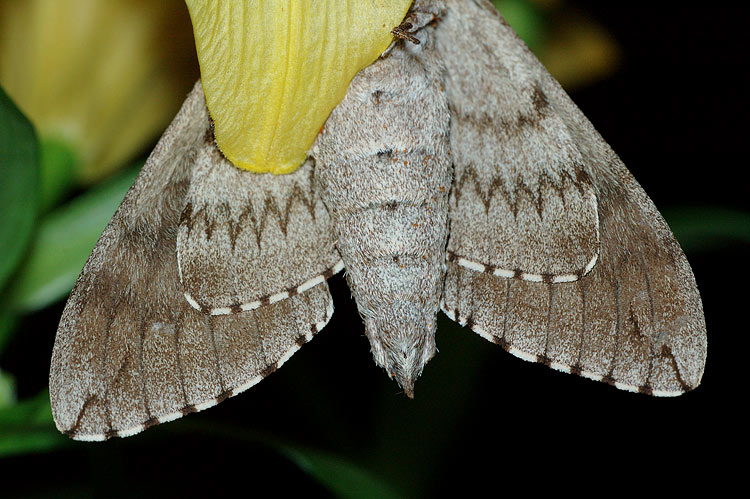
Ceratomia undulosa, (verso) Jasper County, South Carolina,
March 25, 2006, courtesy
of Dr. Wasil Khan.
ECLOSION:
Little is known about the eclosions of the earth pupators, but many believe pupae wiggle toward the surface just prior to emergence.
Below is a specimen with unusually wide, dark bands on the forewings.
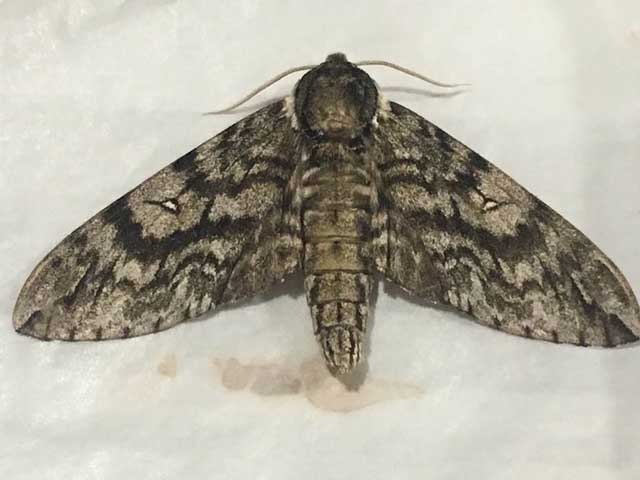
Ceratomia undulosa, Mount Uniacke, Hants County, Nova Scotia,
July 20, 2018, courtesy of Derek Bridgehouse.
SCENTING AND MATING
Females extend a scent gland from the posterior of the abdomen to lure in the night flying males.
Many thanks to Jillian Burrows who sends the following image of Ceratomia undulosa from her area. Jill writes,
"I've contacted you in the past regarding the identification of sphinx moths I had come across while living in the Austin, Texas area. Your website has been truly
very informative and of great help when I've gotten the opportunity to raise larvae. All your work on these sites is awe-inspiring!
"This morning I came across a mating pair in the driveway; I'm uncertain of what they are, but felt inclined to send you a photo. I've never seen a pair before,
and now I hope to find eggs and/or larvae on the vine food source in the backyard - yay! The photo was taken in Mansfield in southern Tarrant County, Texas.
If any more information is needed, please feel free to contact me with any other questions and comments, thank you. I have left the photo in its original size.
you may want to crop if necessary."
I reply, "Thanks for thinking of me, Jill. The moths (Ceratomia undulosa, the Waved Sphinx) are quite susceptible to predators while pairing. I suspect the female hatched from an underground pupa
whose larva fed on a nearby ash tree or privet or lilac bush. This species is not one of the vine feeders.
"The female will readily lay eggs in an inflated green paper lunch bag, once the pair has separated. She is probably carrying over 200 eggs, so you will probably want to release her
after you have obtained some eggs from her. Best of luck."
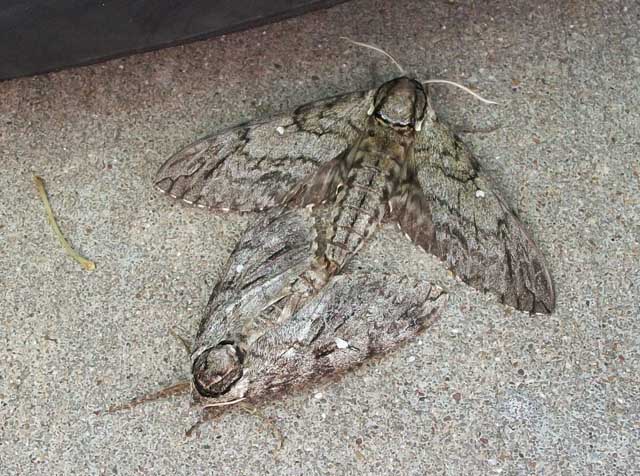
Ceratomia undulosa pairing, Mansfield, Tarrant County, Texas,
August 25, 2011, courtesy of Jillian Burrows.
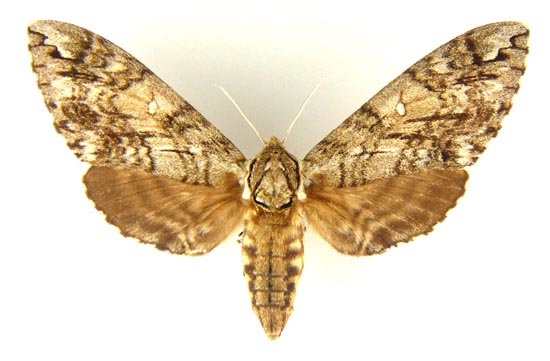
EGGS, LARVAE, PUPAE:Eggs are pale green
and of medium size with incubation lasting about eight days. Larvae
prefer ash but do well on privet and lilac (which I use here).
This third instar larva, courtesy of Tim Dyson, seems to have had
trouble shedding its old head capsule.
| 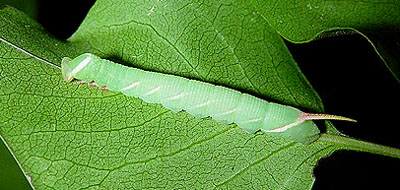 |
There seems to be little change as the larvae
move into the fourth instar.
| 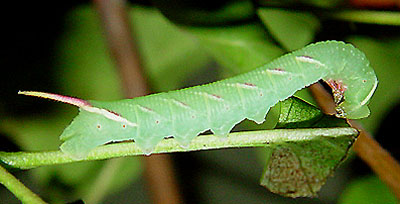
|
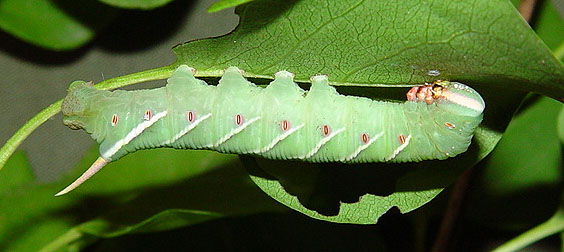
In the fifth instar, the spiracular ovals are decidedly red and the
anal horn is off-white to pinkish laterally. Tim Dyson image.
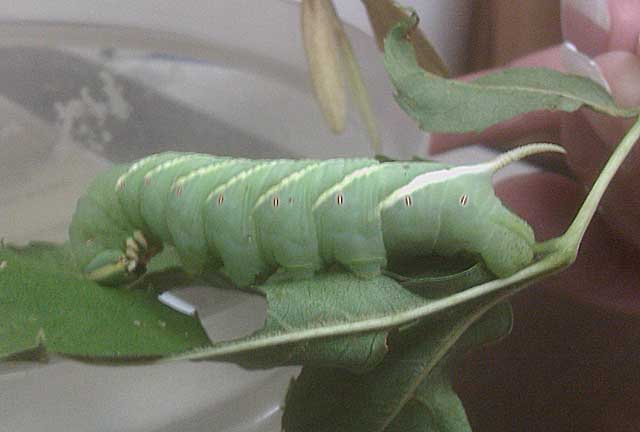
Ceratomia undulosa, Bismarck, Burleigh County, North Dakota,
August 5, 2011, courtesy of Andi Gladson, via Sandy Erickson, tentative id by Bill Oehlke.
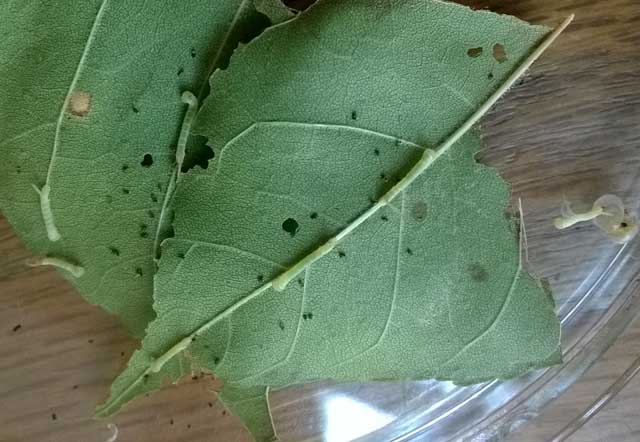
Ceratomia undulosa hatchlings, Whitley County, Indiana,
July 29, 2016, courtesy of Tim Loeffler.
Larvae pupate readily in artificial conditions:
Closed container with loose paper towelling in bottom, kept in the dark at
70-75 degrees F. Pupae are shiny, smooth, and chestnut coloured.
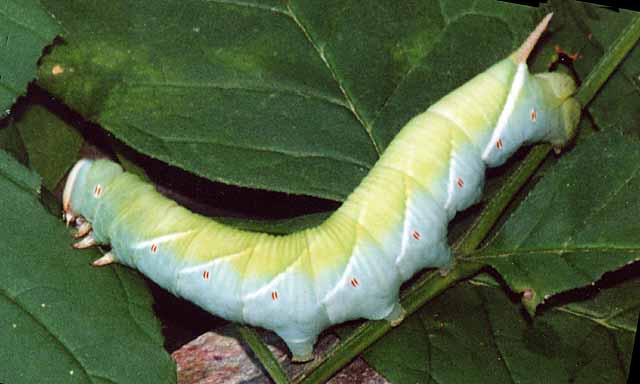
Ceratomia undulosa, Medford, Wisconsin, courtesy of Joan F. Rickert
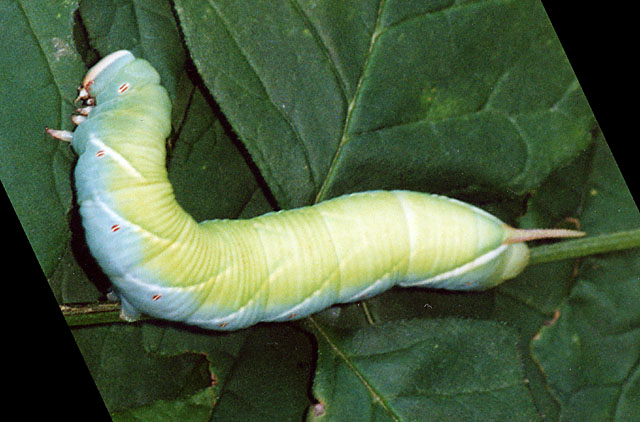
Ceratomia undulosa, Medford, Wisconsin, courtesy of Joan F. Rickert
Just prior to pupation, larvae frequently take on a rosy hue.
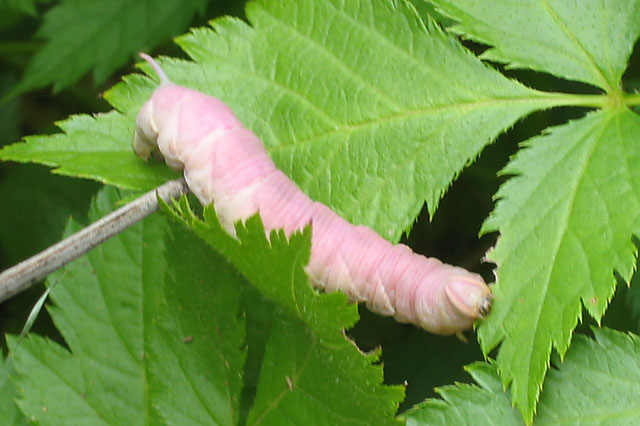
Ceratomia undulosa, Morris County, New Jersey, courtesy of
Gwendolyn Holland,
via Carol Holland, September 14, 2007, prepupal, id by Bill Oehlke.
Fraxinus, Ligustrum, Quercus, Crataegus and Chionanthus virginicus are also listed as hosts.
Although
tongue length is listed at 9.8 mm in W. E. Miller's "Diversity and
Evolution of Tongue Length in Hawkmoths (Sphingidae)" in 1997 Number 1, Volume 51
issue of Journal of the Lepidopterists' Society, my recollection is that
the tongue length exceeds 30 mm as I recall feeding a female a sugar/water/honey
solution summer of 1997 in New Jersey.
The pronunciation of scientific names is
troublesome for many. The "suggestion" at the top of the page is
merely a suggestion. It is based on commonly
accepted English pronunciation of Greek names and/or some
fairly well accepted "rules" for latinized scientific names.
The suggested pronunciations, on this page and on other pages,
are primarily put forward to assist those who hear with internal
ears as they read.
There are many collectors from different countries whose
intonations and accents would be different.
I do not know the origin of the genus choice
Ceratomia, but the first species assigned to this genus
is amyntor. Ceratomia may be a combination of cera (gold)
and tomia (cutting). Speculation suggests the dark cuttings (streaks)
into the golden brown area of the forewing or the golden
checkered fringe of that moth.
The species name "undulosa" is for the
wavy, undulating markings on the wings.
Visit Ceratomia undulosa, Searcy County, Arkansas, March 23, 2012, Marvin Smith
Visit Ceratomia undulosa, Eddie Jones Park, Shreveport, Louisiana, April 15, 2013, Jeff Trahan.
Visit Ceratomia undulosa, Eau Claire County, Wisconsin, May 24, 2011, courtesy of Ian Miller.
Visit Ceratomia undulosa, Plano, Collin Co., May 28, 2011, Peter F. Assmann.
Visit Ceratomia undulosa, Apalachin, Tioga County, New York, June 6, 23, 2011, Colleen Wolpert.
Visit Ceratomia undulosa, Shimek State Forest, Croton Unit East, Lee County, Iowa, June 22, 2013, Thomas Jantscher
Visit Ceratomia undulosa, Ogemaw County, Michigan, June 24, 2012, Cindy Mead
Visit Ceratomia undulosa Malay Falls, Nova Scotia, Canada, June 25, 2016, Derek Bridgehouse; plus variations from Kentucky.
Visit Ceratomia undulosa larva on ash, Medford, Taylor County, Wisconsin, June 30, 2011, Joan F. Rickert
Visit Ceratomia undulosa adult moth, Medford, Taylor County, Wisconsin, June 30, 2011, Joan F. Rickert
Visit Ceratomia undulosa larva, Story County, Iowa, July 6, 2009, Thomas Jantscher
Visit Ceratomia undulosa adult moth, Sidney, Kennebec County, Maine, July 28, 2011, courtesy of Steven Lemieux
Visit Ceratomia undulosa, MV light at McHose Park, Boone County, Iowa, July 13, 2009, Thomas Jantscher
Visit Ceratomia undulosa, Bradford County, Florida, courtesy of Edith Smith.
Visit Ceratomia undulosa, Annapolis, Anne Arundel County, Maryland, August 16, 2010, courtesy of Saundra Byrd.
Enjoy one of nature's wonderments: Live Live Saturniidae (Giant Silkmoth) cocoons.
 | 
Show appreciation for this site by clicking on flashing butterfly to the left.
The link will take you to a page with links to many insect sites. |
Return to U. S.A. Table
Return to Sphingidae Index
Return to Sphingini Tribe

















